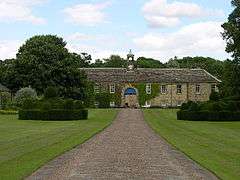Newburgh Priory
| Newburgh Priory | |
|---|---|
 | |
| General information | |
| Type | English country house |
| Location | Newburgh Priory, Coxwold, York, North Yorkshire |
| Country | England |
| Coordinates | 54°10′52″N 1°10′23″W / 54.18111°N 1.17306°WCoordinates: 54°10′52″N 1°10′23″W / 54.18111°N 1.17306°W |
| Owner | Newburgh Priory Estate |
| Website | |
|
www | |
Newburgh Priory is a beautiful family house near Coxwold, North Yorkshire, England. Originally an Augustinian priory, it was founded in 1145 and became a family home following the dissolution of the priory in 1538. It is now a wonderful stately home set within the magnificent scenery of the Howardian Hills with stunning views to the Kilburn White Horse in the distance. The 40 acres of grounds contain an amazing water garden, walled garden, topiary yews and woodland walks.
The house was once the home of the Bellasis family and the seat of the Earls of Fauconberg until the death of Lady Charlotte when the property passed to the eldest son of her sister, Sir George Wombwell, 3rd Baronet. It is now the home of Mr & Mrs S. Wombwell (Mr Wombwell is a son of the seventh Baronet) and their children.
The property is open to the public on Wednesdays and Sundays in April, May and June and also holds numerous other events throughout the year ranging from plant fairs to car rallies. Due to its stunning and tranquil location in an Area of Outstanding Natural Beauty it is a popular location for weddings. With over 40 acres of grounds, magnificent Georgian state rooms, and an atmospheric ruin it provides a wide range of options and beautiful backdrops for wedding photos.
There is also a Glamping site within the grounds of the Priory run by successful Yorkshire glamping firm Yurtshire. The estate that surrounds the house is a traditionally run estate with a mixed portfolio of farm, residential and commercial property together with extensive woodlands and a commercial shoot.
History
The Augustinian priory was founded on lands originally granted by William the Conqueror to Robert de Mowbray. Roger de Mowbray established the priory in 1145.[1] The Mowbrays continued to support the priory, as Roger's grandson, William de Mowbray, was also a benefactor and was buried there in about 1222.[2] Little more is known of the priory from its founding until the Dissolution of the Monasteries in 1538 by Henry VIII, except that Margaret Tudor stayed a night there on 17 August 1503 as a guest of the prior during her progress to meet her husband James IV of Scotland.[3]
Anthony de Bellasis, a royal chaplain, purchased the priory in 1539 from Henry VIII for £1,062. Anthony, with his brother Richard, had been responsible for the dissolution of not only Newburgh, but also eight other monasteries in the north of England. His nephew Sir William Bellasis (1524–1604) converted Newburgh into a private residence in 1546. Having converted the priory, he set the scene for Newburgh as it is today and, except for the alterations and building work carried out between 1720 and 1760, the building remains much the same as it was during the Tudor period. He was appointed High Sheriff of Yorkshire for 1574-75. His eldest surviving son Henry was several times MP for Thirsk, once for Aldborough and High Sheriff for 1603–04. In 1611, he became one of the first baronets. His son Thomas Belasyse, 1st Viscount Fauconberg, also MP for Thirsk, succeeded him and took the title of Fauconberg when created a baron in 1627 (and viscount in 1643). The viscount's grandson Thomas married Oliver Cromwell's daughter and was created Earl Fauconberg in 1689.
The property then descended through several generations to Henry Belasyse, 2nd Earl Fauconberg. On his death in 1802 the earldom became extinct and Newburgh was left to Lady Charlotte, his eldest daughter, who had married Thomas Wynn. He took the surname Belasyse and was High Sheriff in 1810–11. On Lady Charlotte's death in 1825 without male heir, the estate passed to George Wombwell, 3rd Baronet, the son of her sister Lady Anne, who had married Sir George Wombwell, 2nd Baronet in 1791. The 3rd Baronet's son, Sir George Orby Wombwell, 4th Baronet, was a survivor of the Charge of the Light Brigade and High Sheriff of Yorkshire for 1861.
Coal mining was prevalent in the area (as it was in other locations on the North York Moors) and collieries were in existence at Gilling East and Newburgh Priory. These workings finished in the 20th century.[4]
References
| Wikimedia Commons has media related to Newburgh Priory. |
- ↑ Historic England. "Newburgh Priory (56813)". PastScape. Retrieved 18 September 2016.
- ↑
 Tait, James (1894). "Mowbray, William de". In Lee, Sidney. Dictionary of National Biography. 39. London: Smith, Elder & Co. p. 238.
Tait, James (1894). "Mowbray, William de". In Lee, Sidney. Dictionary of National Biography. 39. London: Smith, Elder & Co. p. 238. - ↑ Leland, John, Collectanea, Hearne, Thomas, ed., vol. iv, (1770), 275.
- ↑ Gaudian, Gudrun; Williams, Christoper. "Yearsley Moor Archaeological Project 2009–2013 Over 4000 years of history" (PDF). North York Moors.org.uk. Yearsley Moor Archaelogical Project. p. 47. Retrieved 18 September 2016.